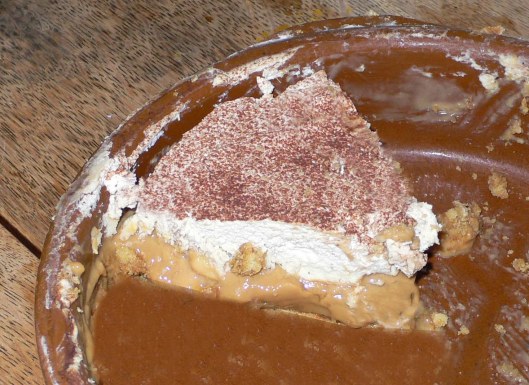Having devoured best part of three deer’s legs (see previous blog), we made sure we had room for some dessert. I hadn’t made this local dish for quite a while, though thankfully it was quite a bit easier than I remembered from previous efforts. When I say ‘local’, I’m referring to Jevington, East Sussex’s finest, Banoffee Pie.
There was a brouhaha which kicked up around 20 years ago when Nigel Mackenzie, inventor of the dish, went to court and managed to extract an apology from Marks & Spencer after they labelled their banoffee pie as ‘American’ – simply because, they said, it fitted in with their range of desserts.
In 1994, Mackenzie, who regretted not patenting the dish, was reported to have offered anyone £10,000 if they could prove that they had made this dessert to his recipe before 1971. It is now widely accepted that banoffee pie as we know it was invented at the Hungry Monk, Jevington, near Eastbourne.

The blue plaque outside the Hungry Monk in Jevington, birthplace of banoffi / banoffee pie
So, to my take on it. If you search t’interweb for an authentic banoffe pie, you’ll find that the base is made of shortcut pastry. So I made one with a biscuit base. For this, I extracted half a packet of digestive biscuits (about 250g) wrapped them in clingfilm so that nothing could escape, and beat the living bejaysus out of them with a rolling pin. I could have used a food processor, which would have been much quicker and more efficient. But I didn’t.
In a wide frying pan, take a hefty lump of butter, (about 100-120g), and melt slowly, toss in the fine biscuit crumbs. Make sure they’re coated all over in the butter. Lightly warm for about five minutes to get a certain butter-cooked-digestive smell; careful it doesn’t burn. Take the crumbs and spread them around the base of the dish you intend to serve the pie in, and press them firmly and evenly. I used a round dish around 25cm across and 5cm deep. The quantity of crumbs there gave a depth of about 1cm.
Cover with foil and place this in the fridge.
Meanwhile – and this is where you have to be careful – take two tins of condensed milk and place them in some gently simmering water for about three hours, making sure the tins are cover in water. Do not pierce the tins first, and make sure you keep an eye on the water as, if it boils dry, you risk turning the tins into potential toffee bombs, ruining your saucepan, your kitchen, and if you’re really unlucky, you.
For the next bit, imagine that three hours have passed by…
Take the tins off the heat, and drain the water from the saucepan. Replace this with cold water as you want the condensed milk, which is now toffee, to cool down.
Open the tins and pour the toffee into a bowl, together with two large (or three medium sized) finely chopped ripe bananas. Mix all these together and pour the gloopy banana/toffee mixture over the now-refrigerated biscuit base, evening it out as you go. Cover with foil again and place this back in the fridge for another hour or so.
Pour a 600ml pot of double cream into a bowl. The original recipe calls for some coffee to be added, which I duly did, along with a capful of not-too-high quality brandy. Whisk this until it goes stiff.
Put the whisked cream on top of the banoffee layer, smooth out and, where the original calls for grated chocolate over the top, I evenly sprinkled some tiramisu-flavoured chocolate powder to finish off.
Three refrigerated hours later, one big banoffee pie was served. I shudder to think of the fat and calorie content, but as our guests Ed & Roz pointed out, and I humbly repeat now, it was rather gorgeous.



Wow, fantastic blog layout! How long have you been blogging for?
you make blogging look easy. The overall look of your web site is magnificent, as well as the
content!